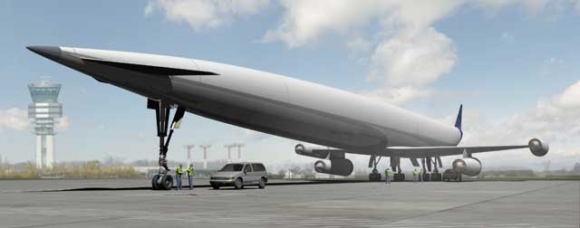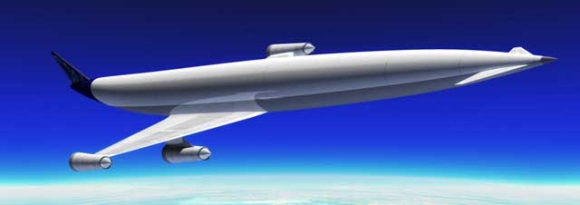A British engineering company has stepped into the commercial spaceflight arena with an ambitious and inspiring design of a possible airliner of the future. The A2, the design behind the Long-Term Advanced Propulsion Concepts and Technologies (LAPCAT) project, will carry 300 passengers, will have a range of 20,000 km and will be capable of travelling twice the speed of Concorde – that’s a sustained velocity of Mach 5. It will also be capable of atmospheric and space flight leading to the exciting possibility of becoming a large vehicle shuttling passengers, astronauts and payloads into orbit…
As private enterprise is beginning to see the possibility of profit in spaceflight, more and more rocket, spaceship and aircraft designs are being realised beyond the realms of science fiction. Richard Branson’s Virgin Galactic and Elon Musk’s SpaceX bear testament to the opportunities that await commercial transport into space. While Branson’s SpaceShipTwo concept uses a conventional WhiteKnight aircraft to “piggyback” until a maximum altitude is reached before it’s rocket engines propel it into space, Musk’s program depends on the ballistic approach, sending his Falcon rocket into space via a conventional rocket launchpad. The A2 concept is different as it will take off and land like a passenger jet without the need to be helped on its way by another aircraft.
The A2 is an impressive looking craft, and the claim that it may be able to sustain hypersonic flight is impressive. Currently, only astronauts leaving or re-entering the atmosphere travel at hyper sonic velocities, no aircraft is capable of such speeds within the Earth’s atmosphere. Mach 5 is the speed at which large amounts of heating occurs on an aircraft’s body, temperatures in excess of 1,800° F (1,000° C), so the engineering of hypersonic aircraft must be sufficiently advanced to protect passengers and aircraft structure from this extreme environment.
The A2 is intended to travel at Mach 5 within the atmosphere so it can enter low Earth orbit, giving it the ability to carry out orbital tasks as well as travelling to international destinations very quickly. It is hoped the A2 will travel from Europe to Australia within four hours. Reaction Engines Ltd. project the A2 will be in full production within 25 years.
The A2 will be able to do this through the use of Scimitar Engines – fueled by huge amounts of hydrogen (indeed, most of the aircraft fuselage will contain the fuel to feed the four engines slung under its wings) – that are designed around existing gas turbine, rocket and subsonic ramjet technology.
See more about the A2 design at Reaction Engines Ltd.
Source: BBC



Boeing was going to make a supersonic cruiser instead of the 787, but customers told Boeing that they would rather have a plane like the 787. I don’t think that Boeing was thinking about a spaceplane, however.
Sounds fast, but it has to be a fuel hog!!!
Somebody was smoking good stuff when they wrote this article. Planning production in several years is real. Twenty-five years means it is a dream.
hello how are you todey please sen a letter to new astronomy
Very simililar in concept to the HOTOL which was touted around in the eighties as the replacement for Concorde and to provide continuity in British/French expertise in passenger supersonic flight. HOTOL was supposed to take off on a sled similar to Fireball XL5 if any of you can remember back that far!
It would be interesting to see an authoritative comparison between the A2 and NASAs efforts to achieve the same goal.
Sorry guys – This dog don’t hunt –
The A2 is described in the article as follows-
“The A2 is intended to travel at Mach 5 within the atmosphere so it can enter low Earth orbit ..”
Onlyest prob – It takes M=25 to get to low earth orbit –
Sorry – Back to dwg board!!
Oh and something else —
The article says —
“The A2 will be able to do this through the use of Scimitar Engines – fueled by huge amounts of hydrogen (indeed, most of the aircraft fuselage will contain the fuel to feed the four engines slung under its wings) – that are designed around existing gas turbine, rocket and subsonic ramjet technology.”
Now look guys – We have all seen the failure of “single-stage-to-orbit” designs in the recent past – for example X-33 efforts.
Single stage to orbit is not easy and currently beyond material (weight/strength) and propulsion capability –
We must await REAL technology breakthroughs before such designs make sense!
Physics loves Staging!!
Where in heaven does Britain get its arrogance thinking they can build another SST when the Concord didn’t even come close to paying its way.. What am I missing here? I think control over economics should come first. What did britain learn from the Concord? What do the numbers say about the cost to build and operate a 300 passenger hypersonic transport?
yes just like the HoTOL from last century.. and as someone else said fireball XL5… gerrry anderson is the jules verne of modern times, way ahead of the A2 boffins
Dave et al. have it exactly right. This should be available about the same time as the Jetson’s flying cars.
The publicists could have at least had the courtesy to credit an old (’60’s) Russian supersonic bomber design.
Gotta love the mini van
Hey! Where are the windows?
So it’s sci fi! Doesn’t sci fi always preceed reality?
Don’t hold your breath waiting for time travel or parallel worlds or, for that matter, easy access to space.
At Mach 5, following the earth’s curvature, passengers will weigh ~20% less. Have you called LAPCAT yet?
Thunderbirds anyone??
You Americans get very tetchy about we Brits when you think we’re on the cusp of doing something you can’t or won’t. I’m guessing you also think Richard Branson is going nowhere with Virgin Galactic!
Concorde was a magnificent machine – a unique beautiful idea* which worked reliably for 30 years – no wonder you didn’t let if fly over US soil – jealousy is a terrible thing guys!
* I admit – the French helped too
I agree with ZEKE.
Call Chrysler and tell them to lay off the design department because the new design for mini vans in 2035 will be the retro 94′ caravan look.
This is just a publicity stunt on the part of the engineering company.
Any 5 year old can draw a picture of a blimp-like plane, put hydrogen engines on it and say it can enter low orbit….at mach 5 thats simply a lie.
Just for the record: Reaction Engines is the company founded by Alan Bond, who designed HOTOL. This is not the orbital version, which is called Skylon and uses an engine called Sabre.
the design is ugly! the numbers are all wrong!
and I doubt seriously doubt that it can perform the way it says it can and still be cost efficient….
To be fair with Britain, It would be a great achievement if this can be built and be proven safe. But I bet this would be twice risky as the Concorde. I’d never ever try to put my life at that risk level even if someone would offer me ride for free.
If the whole Earth is coorperating on a single aircraft that can fly out to the space direct from ground, do you guys think this can be achieved?